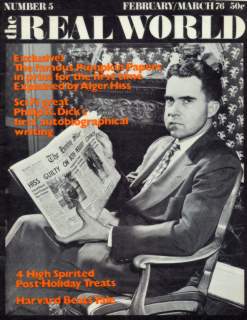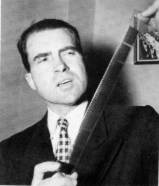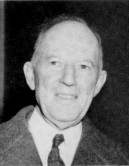| The
Pumpkin Papers and the Baltimore Documents |
 |
 here
were two main components to the physical evidence that Whittaker
Chambers produced against Alger Hiss. According to Chambers,
on November 14, 1948, he went to the home of his wife's
nephew, Nathan Levine.
There, Levine said he had stored an envelope that Chambers
had given him some ten years before. In the envelope were
a batch of papers and several rolls of film. Chambers gave
the papers to Hiss's attorney on November 17. They consisted
of typed copies of State Department documents that Chambers
claimed were typed by Priscilla Hiss and then given to him
for transmission to the Soviet Union. Chambers said he held
onto the pages in the envelope in case he was threatened
by Communist agents after he left the party. Chambers also
produced four short notes about State Department documents
in Alger Hiss's handwriting (Hiss said such scraps were
routine jottings prepared for briefing State Department
superiors). All of those papers, after they were turned
over to Hiss's attorney in Baltimore, became known as the
"Baltimore Documents." here
were two main components to the physical evidence that Whittaker
Chambers produced against Alger Hiss. According to Chambers,
on November 14, 1948, he went to the home of his wife's
nephew, Nathan Levine.
There, Levine said he had stored an envelope that Chambers
had given him some ten years before. In the envelope were
a batch of papers and several rolls of film. Chambers gave
the papers to Hiss's attorney on November 17. They consisted
of typed copies of State Department documents that Chambers
claimed were typed by Priscilla Hiss and then given to him
for transmission to the Soviet Union. Chambers said he held
onto the pages in the envelope in case he was threatened
by Communist agents after he left the party. Chambers also
produced four short notes about State Department documents
in Alger Hiss's handwriting (Hiss said such scraps were
routine jottings prepared for briefing State Department
superiors). All of those papers, after they were turned
over to Hiss's attorney in Baltimore, became known as the
"Baltimore Documents."
Chambers
did not turn the film over to Hiss's lawyer, even though he
was directed by the judge in Hiss's libel suit to turn over
any evidence he had. Instead, he kept the rolls at his Maryland
farm, until the night of December 2, when he concluded the
"Hiss forces" were plotting to steal the evidence.
To protect himself, he took the film and placed it in a hollowed-out
pumpkin behind his home. Then he alerted investigators for
the House Un-American Activities Committee to what he had
done. The investigators soon showed up at the farm with a
subpoena and took the film. Instead of turning it over to
the FBI, as they had been required by the judge in Hiss's
libel suit to do, they took it to an associate in the Veterans
Administration, who developed the film (and exposed some of
it in the process).
|
What
Was in the Pumpkin?
- See
some of the Pumpkin Papers
and read Alger Hiss's comments about them as they
appeared in The Real World magazine
in 1976.
- Richard
Nixon
testimony about the Pumpkin Papers before the Hiss
case grand jury.
- In
1976, journalist I.F. Stone investigated the
history of the Pumpkin Papers. Click
here to read Stone's report.
|
When
the film was developed it was found that the five rolls of
35 mm film (no microfilm) contained photographs of government
documents. This batch of films was soon dubbed the "Pumpkin
Papers." It consisted of photographs of both State Department
documents and publicly available Navy Department papers. The
Navy documents that could be developed dealt with such matters
as the color to paint government fire extinguishers. None
of this latter material was introduced at trial.
 |
| Richard
M. Nixon examining the Pumpkin film. |
The
House Un-American Activities Committee leaked portions of
the Pumpkin Papers that had come from the State Department,
claiming that the material was secret and that Hiss was the
likely source.
The
controversy about the contents of the Pumpkin Papers, their
value and the origin of the film itself continues to this
day.
Many
Saw Papers, State Aides Say
 |
| Assistant
Secretary of State Francis B. Sayre |
In
December 1948, an article in The Washingon Post claimed
the documents which Alger Hiss was accused of handing to a Communist
spy ring - both the Pumpkin Papers and the Baltimore Documents
- were accessible to dozens of persons, both inside and out
of government. Click here
to read the article.
Francis
B. Sayre testified before the grand jury that the
Pumpkin Papers were circulated among many government officials
besides Alger Hiss. Click here
to read excerpts from his recently released testimony about
both the Pumpkin Papers film and the typed Baltimore Documents.
|

